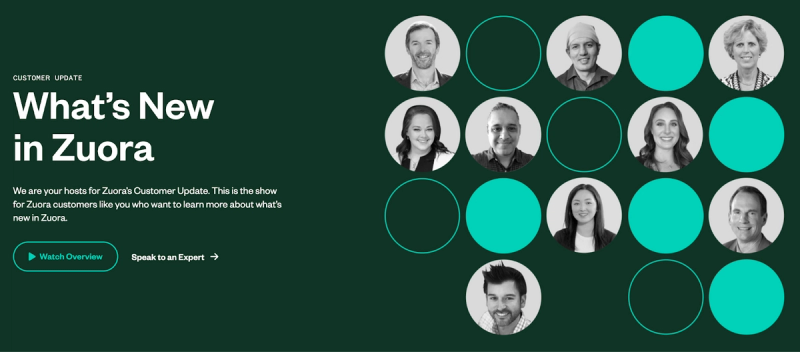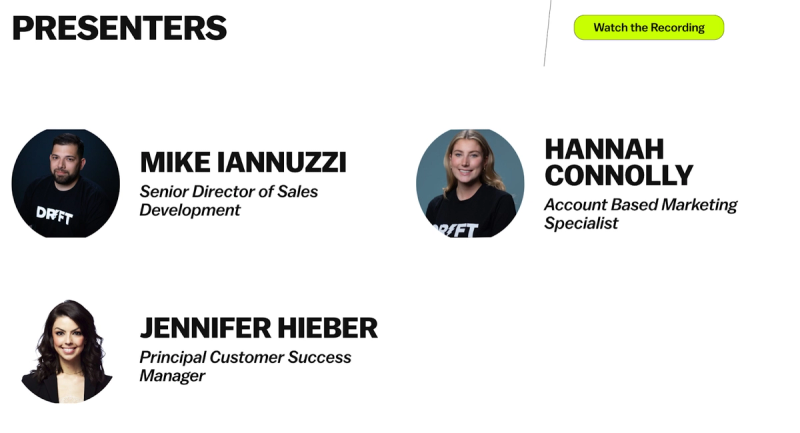Rev Up the Revenue: How To Make Events a Top Earning Channel for Your Company

Maximize Your Marketing ROI
Join 10,000 other marketers already getting the best tips on running engaging events that boost pipeline and create raving fans.
It's no secret that the economic outlook in 2023 is very uncertain. Everywhere you turn, you see conflicting headlines: strong job markets, mass layoffs, looming recessions, post-pandemic recovery…it can be hard to know what to think.
In the midst of unpredictable forecasts, many organizations are cutting back on their budgets, including money spent on staff, advertising, tech, and—you guessed it—events. While that might make sense on paper (saving money is saving money, right?), we're here to persuade you that this is actually a great time to lean into your events strategy, not away from it.
Here's why: We've seen firsthand that events can be a top revenue-earning channel. But for that to happen, you need to weave them into the fabric of all your channels. Events aren't just for marketing; they're for the product teams, your customer success folks, the internal training department, and everyone else!
Today, we'll talk about how to make events a top revenue earning channel for your company. Here’s a quick look into how to make that happen:
- Align expectations across your teams
- Set revenue-related event goals
- Understand how to measure success and whether events are influencing revenue
- Host events across all stages of the customer journey
- Integrate events across departments
Align expectations across your teams
Historically, events have been considered a marketing function. These days, however, events should be a critical part of your overall sales strategy. It benefits everyone to make sure events are successful and profitable.
This synergy won't just happen on its own, though. You'll need to set an expectation across your teams that events are a part of every department's strategy. Encourage your teams to think about how they can contribute to events or to come up with ideas about what type of events might work for them.
For example, your product launch team might let you know that they'd like to host a series of product launch events, timed to coincide with specific products that they're bringing to market. At the same time, your customer success team might come up with some great webinar ideas, based on recurring questions they get from new customers.

Zuora’s series, What’s New in Zuora, is a great example of a company relying on all their teams to use events to drive customer acquisition, expansion, and renewal. These events combine their marketing, product, and customer teams to produce cross-functional events that get all teams aligned on the importance of events.
As you know, events aren't just a one-and-done thing—so don't let collaboration fall by the wayside afterward, either. Continue to check in with your different teams or create recurring meetings that bring everyone together to talk about events. That way, events are always fresh on everyone's mind.
💻Related: 13 Types of Virtual Events to Boost Your Revenue and Results
Set revenue-related event goals
We'll be blunt: If you're not setting revenue goals for your events, they're probably not going to generate a lot of revenue.
Your goals inform the way you approach every event, from promotional efforts to creating the Run of Show for each individual event. That's why, if you're trying to increase revenue, you need to spell that out when you're setting your event goals. Setting these targets is a fundamental part of ensuring you're putting on profitable events.
If you're not sure where to start, try looking at your historical data to come up with a reasonable baseline to start from. You can also use a digital events ROI calculator to get a better understanding of your overall event ROI and set expectations from there.
Revenue as a bottom-of-funnel goal
Generally speaking, revenue as a specific goal is used for your bottom-of-funnel events. These are events where the audience is familiar with your brand, and you're focused on closing the deal.
However, this doesn't mean that top-of-funnel and middle-of-funnel events don't contribute to revenue! They're all necessary to move the customer along toward that final stage; you just may use other goals to determine whether those events were successful or not.
If you need guidance, check out these goal examples corresponding to every stage of the customer journey.
The key to setting (and hitting) goals
Whether you're aiming for a certain number of conversions, demo requests, or straight-up sales after an event, share your goals across teams to ensure everyone's still on the same page. Like we just talked about, this isn't one-and-done!
Talk about events and the goals you've set for them as often as possible to be sure events are always part of larger conversations around strategy.
PS: If you realize you don't have good data on any of the numbers in the ROI calculator, that's an indication you need to start tracking that info. A good events platform, like Goldcast, will provide all the analytics and dashboards you need to prove ROI of your events.
Understand how to measure success and whether events are influencing revenue
We just talked about how not all events will be directly tied to a hard-and-fast revenue number. People who attend their first event to learn more about your brand or product aren't super likely to buy right away; they may need to come to another event and get more information, meet other customers, and learn more about your company culture.
So, if you can't always look straight to your bottom line, how can you tell whether events are successful? The answer is that you'll need to set KPIs for each event that you can use to track your progress and profitability.
Setting KPIs
The KPIs that you choose for each event will depend on a number of things—namely, what stage of the customer journey your audience is in, who's hosting the event, and what the CTA is.
If you're hosting an event for a general audience to learn more about your product, perhaps you'll be honing in on how many people either attended or watched the on-demand event recording. That'll clue you in to how many people actually received the message.
On the other hand, if you're putting on an event for an audience that's more familiar with your product, perhaps you'll zero in on how many product demos were requested. At Goldcast, we consider a demo request a "hand raiser" lead and try to follow up with these people as soon as possible after an event. They're essentially telling you outright that they want to see whether your product can work for them!
We know that B2B marketers can have quite the time tracking event ROI. We used to have the same struggle ourselves! That's why we created the Goldcast ROI Dashboard, which will highlight exactly how your events did and how they're contributing to your pipeline and revenue goals. With the ROI Dashboard, there's no more wondering: all of the data you need is there, in an easy-to-share format!
👋Hey, you! Want to dive more into all things event ROI? Check out our Event ROI Bootcamp series, available on-demand now!
Host events across all stages of the customer journey
You may have guessed this one by now, but you want to be sure you're putting on events for customers at every stage of the journey. Don't let revenue steal the show as the only goal and miss out on the chance to nudge your top-of-funnel and middle-of-funnel folks closer to a conversion!
Events are such a great tool for getting more eyes on your product, engaging customers, creating community, raising awareness, and, yes, boosting revenue. You can plan events that target every stage of the buying process so that you're always engaging with people, no matter where they are in their decision-making cycle.
🌪️Top-of-funnel (ToFu)
Early on, people mostly just want information. They want to learn more about you, your product, and what you're all about. To that end, general webinars and educational sessions can go a long way.
Goals for this type of content should focus on registrations, live attendees, number of key prospect accounts attending, and whether the leads return to your content post-event.
🌪️Middle-of-funnel (MoFu)
Here, people are interested but they still want more information before they decide. Make sure that every touchpoint here offers something valuable and engaging. Perhaps it's a timely workshop helping your audience work through a challenge, or maybe you host a networking event to allow industry professionals to get together and talk about best practices.
The best goals to set here are for content downloads, Q&A participation, post-event website visits, and revenue sourced and/or attributed.
🌪️Bottom-of-funnel (BoFu)
Your bottom-of-funnel prospects are almosttttt there. They just need a bit of convincing to make that purchase! At this point, you might dive deep into a case study that illustrates how your product helped a customer. Or maybe you even have satisfied customers come on stage and share their testimonials with an audience!
At this stage, the goals should be focused on revenue, creating opportunities, getting people into demos, and other high-intent conversion points.
A lot of times, companies spend most of their energy planning top-of-funnel, introductory type events and overlook the other two stages of the funnel. While ToFu events may bring a lot of eyes to your product, they alone won't accomplish your desired pipeline and revenue outcomes. For best results, be sure that you have a proportional event strategy that speaks to customers throughout the entire journey.
How to integrate events across departments
Okay, so now you know that events aren't just a marketing function—but perhaps you're unsure of what it actually looks like to get your other teams involved. Here are some examples you can use as inspiration!
Product

Your product teams are good candidates for hosting quarterly roadmap presentations, monthly live demos, and open Q&As with product leaders. Audiences will be able to get their questions answered on the spot and see exactly how your products work, resulting in customer retention and expansion.
For example, Clari leaned on its Director of Product Management and a Product Lead to demonstrate how its RevGPT product works. The audience was able to see Clari's new AI-powered tool and understand how it can save them time.
Customer success
Recurring "story sessions," in which a CSM and customer talk in real time about how your product helped a customer achieve their goals, are great ideas for your customer success folks. You could also create a monthly series for CSMs to share their top product tips and hacks or invite CSMs to present on vertical-specific webinars.

Calendly took this approach when it hosted a webinar on how Calendly success leaders use their own product to accelerate onboarding and engage with clients throughout their journey.
Professional services
Having your pro services team host paid training events can ensure that multiple customers are trained at once; events like this also allow customers to network with each other and grow their sense of community within your brand. The focus of events like these should be on complicated, in-depth processes.
For instance, in this ongoing admin training, Onspring provides several training passes to help current clients and partners get up-to-speed on the product.
At the end of a pro services event, customers should walk away with something tangible, whether that's a new integration, a template they can put to use after the event, a unique workflow, or something else related to your product or service.
ELT/Technical teams
You can see in this Seismic webinar that the subject matter is both technical and expansive: What does AI mean for the future of work? The company had its CMO moderate and guide the conversation.

Likewise, you can encourage ELT members to host events related to their function and expertise. These could be invite-only fireside chats for certain audience members or larger-scale webinars with a broader audience.
Sales
It's always a good idea to include sales in your event planning process; they can help you come up with new ideas that propel pipeline and speak directly to audiences. They might be good speakers for your own webinars and events, and they're also great SMEs to pitch for other companies' events.
You can see in this Sendoso event that the company featured its own VP of Sales Development in conversation with another CEO and founder. Attendees learned more about Sendoso but were also exposed to an entirely new company and POV as they learned about how to land more sales meetings.
Bonus: Combine teams!
Your teams don't exist in a silo; why not bring them together for even better event ideas? Leveraging multiple departments for a single event (or series) provides multiple perspectives and reaches a larger, more diverse audience.

Drift nailed this strategy with its "Drift on Drift" events, which feature people from different areas of the company. Getting to hear from someone in sales, another person in account-based marketing, and a third person from customer success means attendees enjoy a well-rounded discussion and holistic takeaways.
Final note: This isn't just a numbers game where you host tons of events, just to make sure you're including all departments. You want to be strategic here! The ultimate goal is to make events a solid portion of your revenue pie chart and to do that, you'll need everyone's help.
Goldcast can support your comprehensive event strategy
Ready for a platform that makes hosting events a breeze? Goldcast is set up to empower B2B event marketers to provide consistent, engaging event experiences that dazzle and convert your attendees.
Goldcast is your one-stop shop to not only set up and host amazingly on-brand events, but to track and measure event ROI over time. We take all the stress out of event management and, if you ever have a question or find yourself in a pickle, our dedicated support team has your back.
You've learned a lot today about how events can translate to increased revenue. From aligning expectations across teams to hosting events for every stage of the customer journey, you now know what to keep in mind as you plan your next event.

Transform Your Video Marketing with AI
Stay In Touch
Platform
Resources
© 2025 Copyright Goldcast, Inc. All rights reserved.





 Upcoming Events
Upcoming Events Event Series
Event Series On-Demand Events
On-Demand Events

